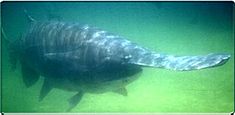- American paddlefish
-
American Paddlefish 
Conservation status Scientific classification Kingdom: Animalia Phylum: Chordata Class: Actinopterygii Order: Acipenseriformes Family: Polyodontidae Genus: Polyodon
Lacépède, 1797Species: P. spathula Binomial name Polyodon spathula
(Walbaum in Artedi, 1792)The American paddlefish, Polyodon spathula, also called the Mississippi paddlefish or spoonbill, is a paddlefish living in slow-flowing waters of the Mississippi River drainage system. It appears to have been extirpated from Lake Erie and its tributaries. They are closely related to the sturgeons. This large Chondrostean freshwater fish may grow to 220 cm (7 feet) and weigh up to 100 kg (220 pounds). The paddlefish takes its common and scientific names from its distinctive snout, which is greatly elongated and flattened into a paddle shape. The American paddlefish is believed to use sensitive electroreceptors on its paddle to detect prey, as well as to navigate while migrating to spawning sites. The American paddlefish feeds primarily on zooplankton but also feeds on crustaceans and bivalves. Polyodon spathula is one of two living species of Paddlefish; the other is the possibly extinct Chinese Paddlefish, Psephurus gladius.
Population decline
Though the American paddlefish was once common throughout the Midwest, overfishing and habitat changes have caused major population declines; both the meat and roe of Polyodon spathula are desirable as food. Dams and other barriers can prevent the fish from recolonizing places where they once occurred and can deny them access to important critical habitats such as spawning areas. Until about 1900, the species was also found in Lake Erie and in river systems tributary thereto in the U.S. and Canada. Invasive species such as zebra mussels have reduced the number of zooplankton in the Great Lakes to such low levels that any hypothetical reintroduction program would seem likely to fail. Recently, paddlefish were spotted in the Danube river. It has not been determined whether these fished escaped from Romanian or Bulgarian fish farms during the 2006 European floods, or whether they were let into the Danube earlier and matured in the river.
Sport fishing
The American paddlefish remains a popular sport fish in those parts of its range where populations are sufficient to allow harvesting. Since they are filter-feeders, paddlefish will not accept bait or lures and must be caught by snagging. Several states, including Missouri, have enacted stocking programs for these fish in reservoirs where the resident populations were low or nonexistent, or in areas where historical populations are no longer naturally sustainable. Paddlefish roe is occasionally sold as "American Sevruga Caviar"[1].
References
- Grady (2004). Polyodon spathula. 2006. IUCN Red List of Threatened Species. IUCN 2006. www.iucnredlist.org. Retrieved on 11 May 2006. Database entry includes a lengthy justification of why this species is vulnerable
- "Polyodon spathula". Integrated Taxonomic Information System. http://www.itis.gov/servlet/SingleRpt/SingleRpt?search_topic=TSN&search_value=161088. Retrieved 30 January 2006.
- Froese, Rainer, and Daniel Pauly, eds. (2005). "Polyodon spathula" in FishBase. 10 2005 version.
- Barry Patrick M., Robert F. Carline, David G. Argent, William G. Kimmel. 2007. Movement and Habitat Use of Stocked Juvenile Paddlefish in the Ohio River System, Pennsylvania. North American Journal of Fisheries Management 27:1316-1325
- Bettoli Phillip W., George D. Scholten, William C. Reeves. 2007. Protecting Paddlefish from Overfishing: A Case History of the Research and Regulatory Process. Fisheries, American Fisheries Society 32:390-397
- Boone, E.A., and T.J. Timmons. 1994. Density and natural mortality of paddlefish,Polyodon spathula, in an unfished Cumberland River subimpoundment, South Cross Reservoir, TN. Journal of Freshwater Ecology 10: 421-431
- Cheblukov V. P., V. Ye. Kharin. 2009. The First Finding of the American Paddlefish "Polyodon Spathula" (Polyodontidae)in waters of the Russian Far East. Russian Journal of Marine Biology 35:611-613
- Miller S. E., D. L. Scarnecchia. 2008. Adult paddlefish migrations in relation to spring river conditions of the Yellowstone and Missouri rivers, Montana and North Dakota, USA. Journal of Applied Icthiology 24:221-228
- Onders Richard J., Steven D. Mims, Carl D. Webster, Ann L. Gannam. 2009. Apparent digestibility coefficients of protein, lipid and carbohydrate in practical diets fed to paddlefish, "polyodon spathula" (Walbaum). Wiley Interscience 40:1785-1788
- Pitman, V.M., and J.O. Parks. 1994. Habitat use and movement of young paddlefish, Polyodon spathula. Journal of Freshwater Ecology 33:181-190
- Rosen, R.A., and D.C. Hales. 1981. Feeding of paddlefish,Polyodon spathula. Copeia 2:441-455
- Russell, D.F., L.A. Wilkens, and F. Moss. 1999. Use of behavioural stochastic resonance by paddlefish for feeding. Nature 402:291-294
- Scholten, G.D., and P.W. Betoli. 2005. Population characteristics and assessment of overfishing for an exploited paddlefish population in the lower Tennessee River. Transactions of the American Fisheries Society 134:1285-1298
- Zigler, S.J., M.R. Dewey, B.C. Knights, A.L. Runstrom, and M.T. Steingraeber. 2004. Hydrologic and hydraulic factors affecting passage of paddlefish through dams in the upper Missouri River. Transactions of the American Fisheries Society 133:160-172
Extant sturgeon and paddlefish species Kingdom Animalia · Phylum Chordata · Subphylum Vertebrata · Superclass Osteichthyes · Subclass ChondrosteiAcipenseridae Polyodontidae PolyodonAmerican paddlefish (P. spathula)PsephurusCategories:- IUCN Red List vulnerable species
- Polyodontidae
- Fish of North America
- Monotypic fish genera
- Animals described in 1792
Wikimedia Foundation. 2010.


